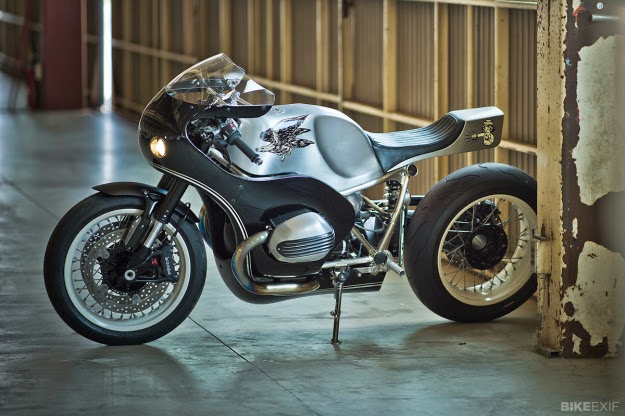For six months, four of Japan’s top custom workshops have been tearing down and rebuilding BMW’s R nineT roadster.
The names will be familiar to most readers—Shiro Nakajima, Brat Style, Hidemo and Cherry’s Company—but until now, the R nineT Custom Project bikes have been hidden behind closed doors.
The results are being revealed this very minute by BMW design chief
Ola Stenegärd at the BMW Motorrad Days in Nagano, and we’ve got
exclusive images of the builds right here.
It’s a masterclass in the art of customizing bikes, and proof that
the Japanese builders are in a league of their own. The craftsmanship,
styling and sheer creativity on show is remarkable.
Enjoy.
CHERRY’S COMPANY HIGHWAY FIGHTER Kaichiro Kurosu is not
so well known in the West, but in the Japanese motorcycle industry he’s
a household name. His high impact bikes have won the top trophy two
years in a row at the Yokohama custom show, and his R nineT is just as
amazing. For inspiration, Kurosu looked to BMW’s long history, and
decided to create a machine that feels, in his words, ‘near future.’
The wheels are modified Custom Chrome RevTech Billet items, going up a
size to 18” at the front and down a size to 16” at the back. They’re
shod with Metzeler ME880 Marathon tires. The forks are standard R
nineT—originally specc’d for the S1000RR—but dropped two inches with
custom internals and coated black for an extra stealthy look.
The rear frame has been modified, along with the top yokes and steering
stem, and there’s an upgraded Brembo master cylinder to boost braking
power. The foot controls are custom fabricated and the clip-on bars are
from ABM.
The hand-beaten aluminum bodywork is a styling tour de force,
and could be straight off the set of a Dark Knight movie. Check out the
front of the frame: the skeletal mesh enclosure that blends with the
tank and belly pan is a work of art.
Custom Project Diary | Cherry’s Company website
BRAT STYLE CYCLONE Go Takamine is one of the most
influential motorcycle builders in the world. His shop, BratStyle, is
synonymous with the look of new wave customs, and has spawned a thousand
imitators.
There’s always a visual lightness and vintage flavor to BratStyle
builds, and those aspects have come to the fore on Takamine’s R nineT.
Given the stock bike’s heavyset nature, the feeling of delicacy on this
machine is quite remarkable.
Takamine’s goal was to create a bike for short city trips, with a mix
of old and new flavors and a dirt track vibe. The front end is all
Ceriani, including the forks, the steering stem and damper, and the top
yoke.
The wheels have gone up in size, with a 19” at the front and an 18” at
the back. (The rims are Akron H-style.) And being a traditionalist at
heart, Takamine has not only removed the ABS, but also fitted a
twin-leading shoe front drum brake. The tires are Allstate Safety Tread.
The bodywork is all-new and has transformed the appearance of the R
nineT. There’s a custom aluminum front engine casting, and the cylinder
heads have been plated and polished to match. The icing on the cake is a
simple hand-fabricated exhaust system straight out of the 1960s.
Custom Project Diary | BratStyle website
HIDE MOTORCYCLE BOXER The simple, organic designs of
Hideya Togashi have been charming Japanese custom fans since 2003; today
he’s one of the leading Harley Sportster builders in the East.
Togashi has taken a minimalist approach, looking for maximum impact
from relatively few mods. The hand-beaten, unfinished aluminum bodywork
is timeless and flowing, giving the R nineT a super-sleek look with a
hint of 1970s GP bikes.
New cylinder head covers have a sandcast-style texture, and the frame
has been returned to a lighter, more natural finish. The wheels are
actually stock—but again, the black finish has gone, swapped out for a
light powdercoat. The rubber is Metzeler’s Racetec Interact.
The exhaust system is easy to miss, but beautifully bent and routed.
The headers curve back into the frame and then vent near the under-seat
shock. And the custom foot controls echo the new frame finish just
perfectly.
Custom Project Diary | Hidemo website
46WORKS CLUBMAN RACER Shiro Nakajima is no stranger to
these pages. Under the Ritmo Sereno moniker, he’s built some of the most
intoxicating custom BMWs and Moto Guzzis we’ve ever seen. Nakajima has
just gone back to basics with a new shop, 46Works, and builds
race-flavored customs that work on the track as well as on the road.
His R nineT is bristling with lightweight parts that reduce the
weight by around 30 kg. The stock Sachs forks are gone, replaced by
Ohlins items matched to a modified steering stem and top yoke. The
wheels are MotoGP-style Bito R&D Magtans running Pirelli Diablo
Supercorsa rubber.
The exhaust system is hand-built titanium, and Nakajima has crafted a
titanium ram-air intake too. Interestingly, he’s also removed the ABS
system—presumably to suit his riding style on the track. Ancillary
components are from the very best Japanese brands, including Earl’s (oil
cooler), Posh and Daytona (lighting) and Battle Factory (clip-ons).
The biggest challenge for Nakajima was hand-beating the new aluminum
bodywork: as a man who usually focuses on mechanical upgrades to his
bikes, this was a new experience for him. The result is immaculate
though, and topped off with subtle paint and a traditional pinstripe.
Custom Project Diary | 46Works website
To see more of these bikes and the stories behind the builds, visit the official R nineT Custom Project website. Or read our follow-up interviews with the builders here.
appeared first on Bike EXIF.
Showing posts with label Cafe racer. Show all posts
Showing posts with label Cafe racer. Show all posts
Monday, September 1, 2014
Monday, August 25, 2014
BMW Monolever by Flat Racer
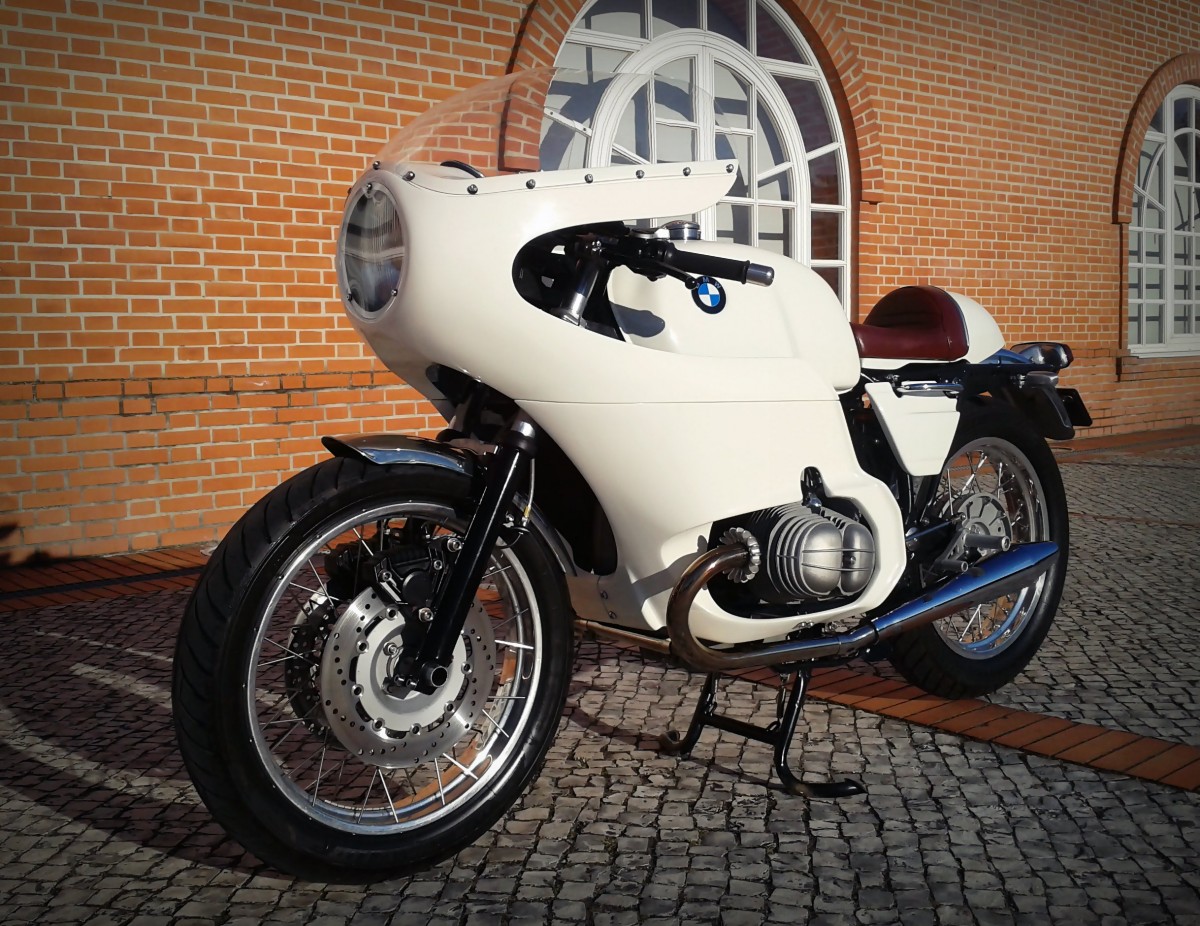 Flat Racer
is a boutique London-based company that produces some eye-catching
accessories for vintage BMW motorcycles, the bike you see above started
life as a stock 1990 BMW Monolever before being kitted out in a new full-fairing – giving it an entirely new lease on life.
Flat Racer
is a boutique London-based company that produces some eye-catching
accessories for vintage BMW motorcycles, the bike you see above started
life as a stock 1990 BMW Monolever before being kitted out in a new full-fairing – giving it an entirely new lease on life.When the team at Flat Racer set out to design the fairing they made a point of ensuring that it could be fitted without irreversibly altering the frame – this may not sound like much but the process took 5 years to complete.
Shakedown testing on the prototype (pictured here) revealed that it had a higher top speed than the stock bike, with slightly better fuel consumption and an improved riding position – not to mention the fact that it looks an order of magnitude better than the original OEM BMW fairing that hasn’t aged particularly well.
If you’d like to read more about the fairing kit, you can click here to visit Flat Racer – just be warned, you’ll spend the next few days hunting around your local classifieds looking for affordable Monolevers.
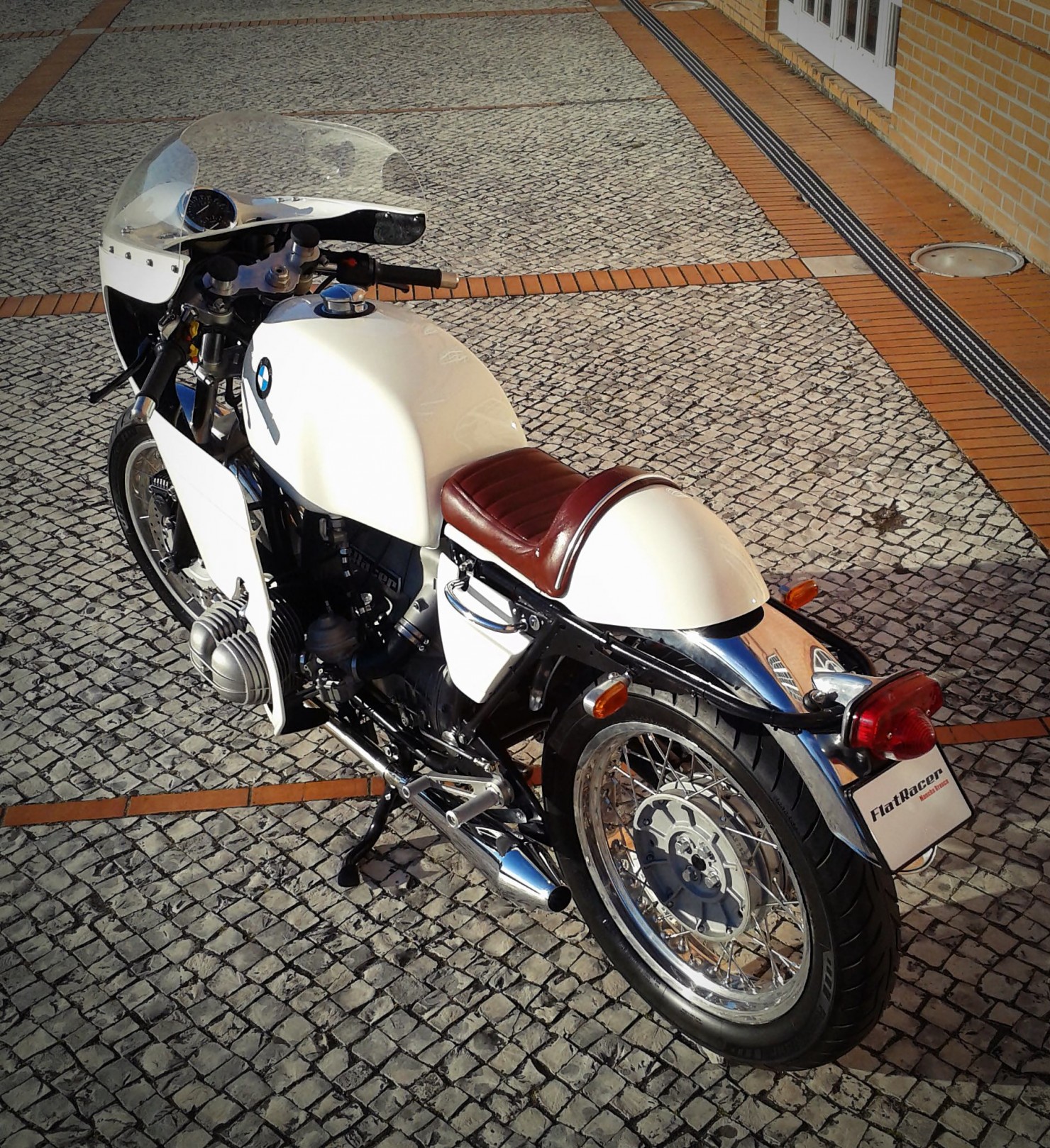
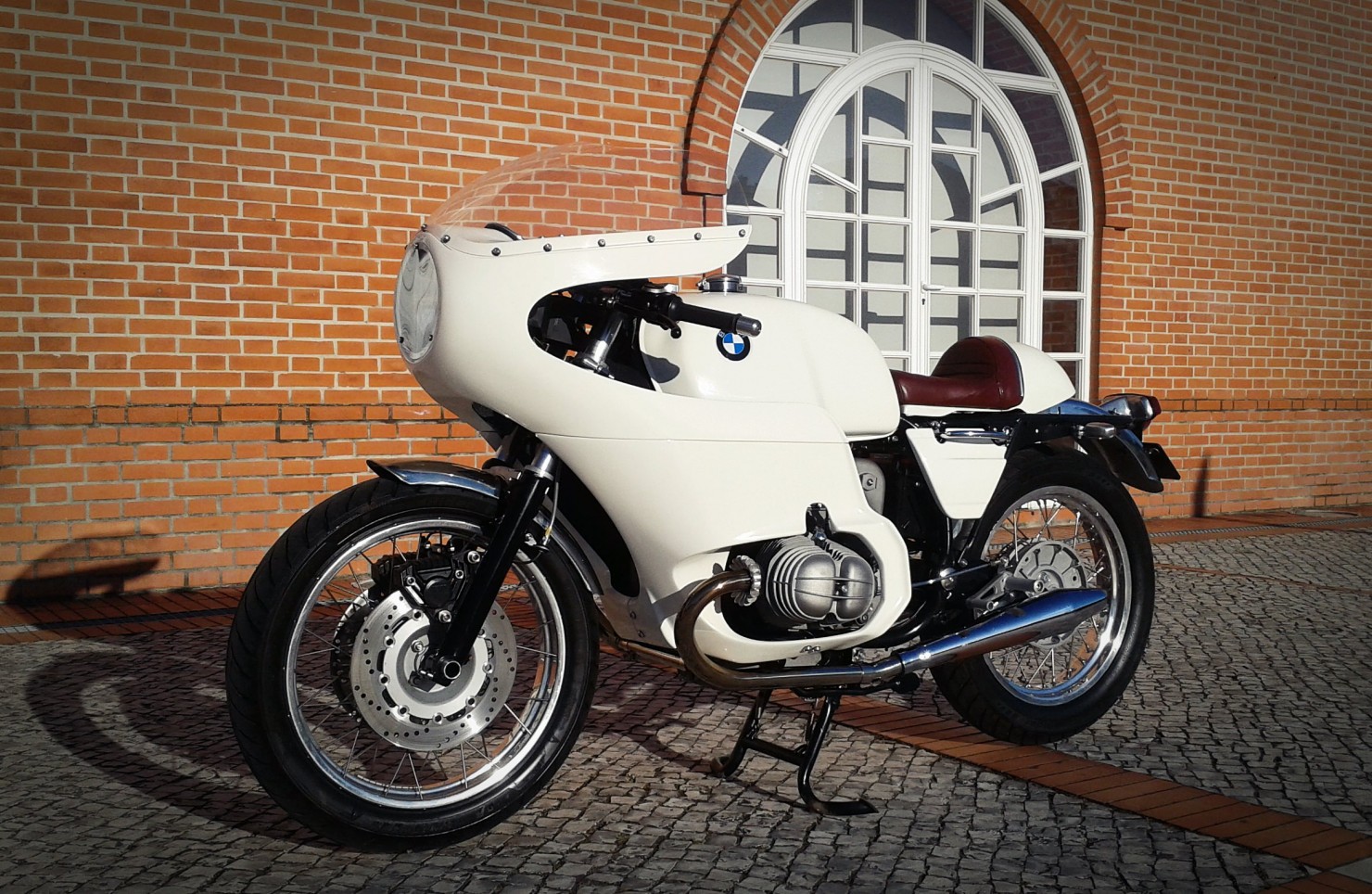
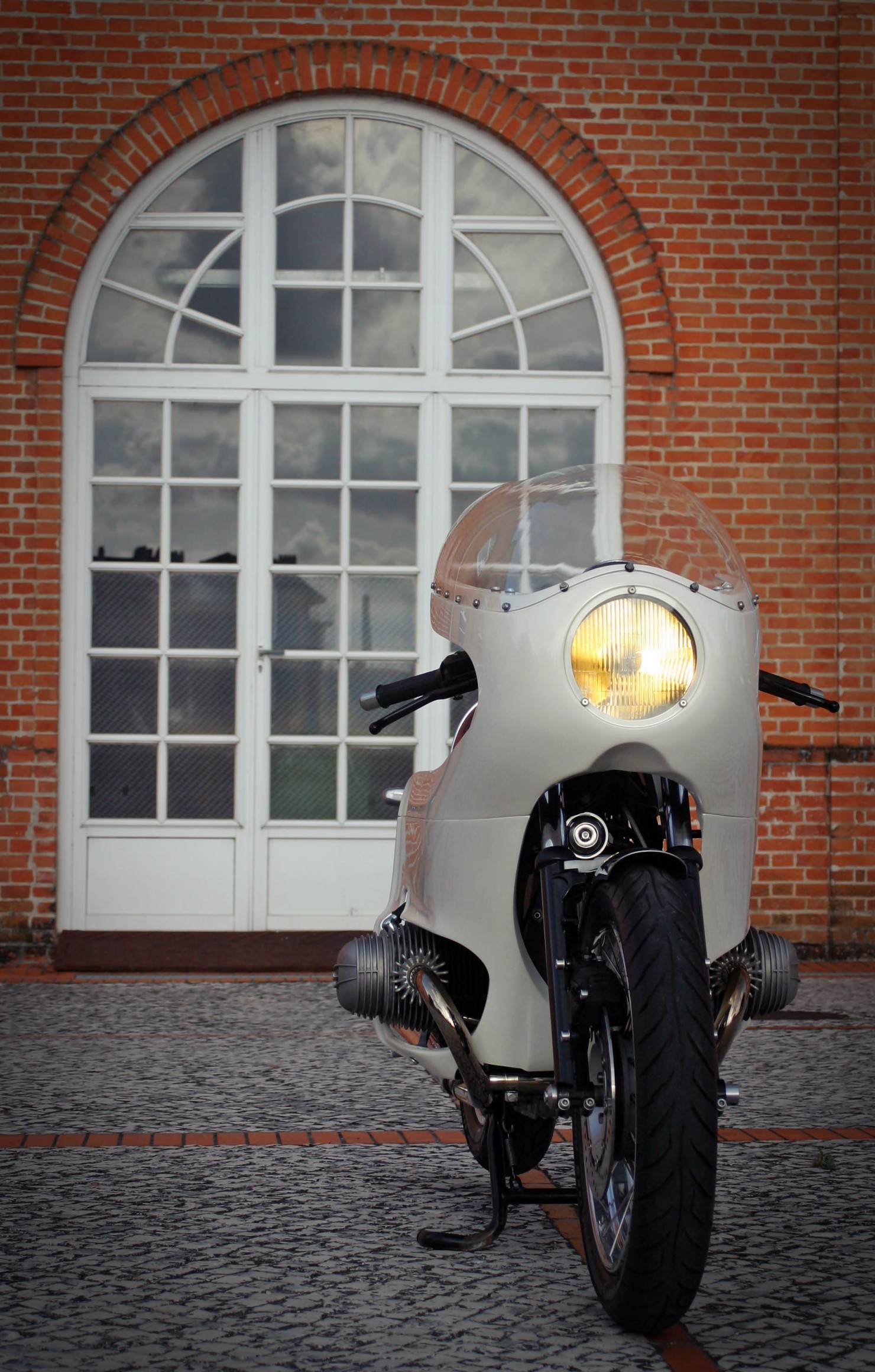
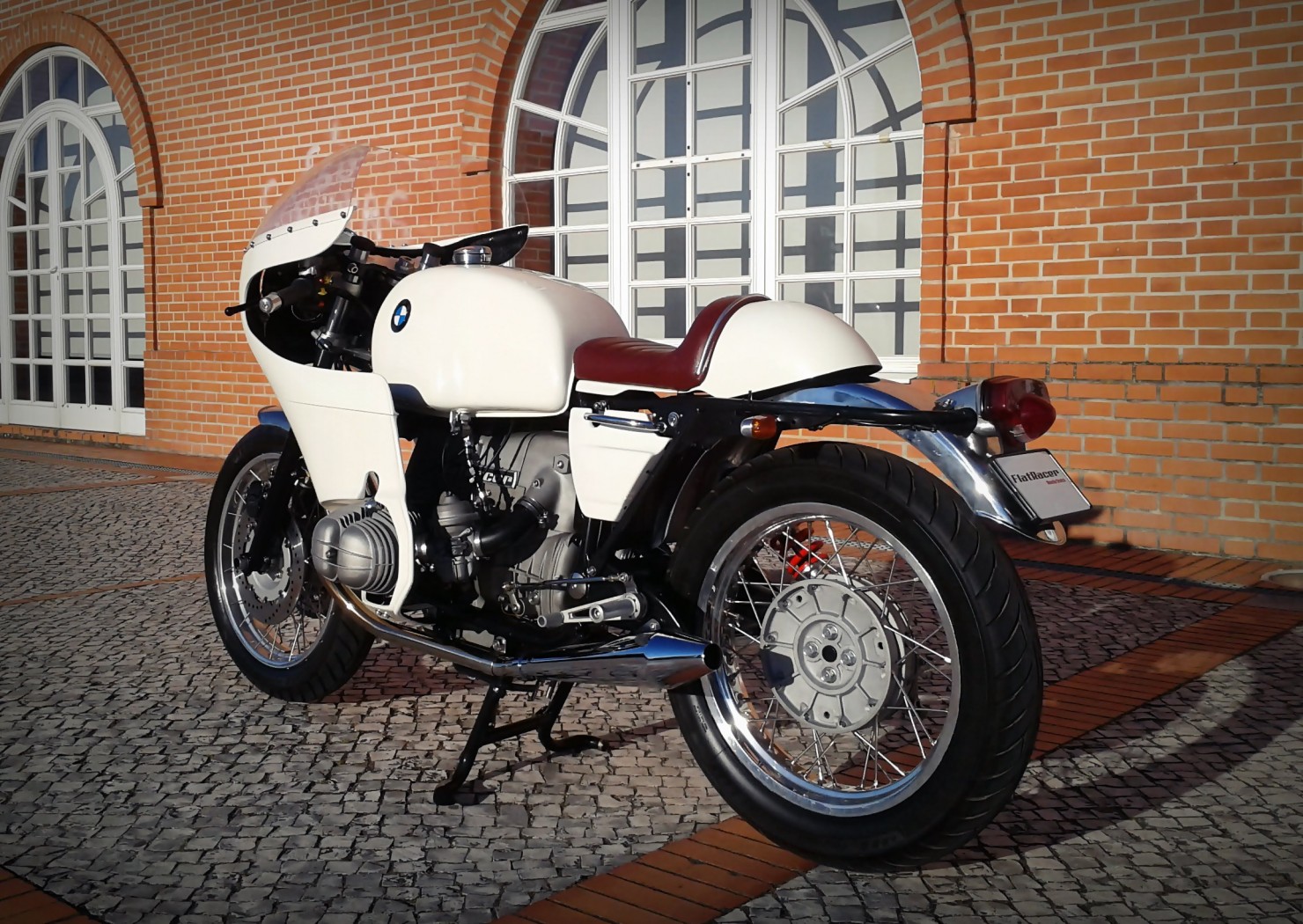
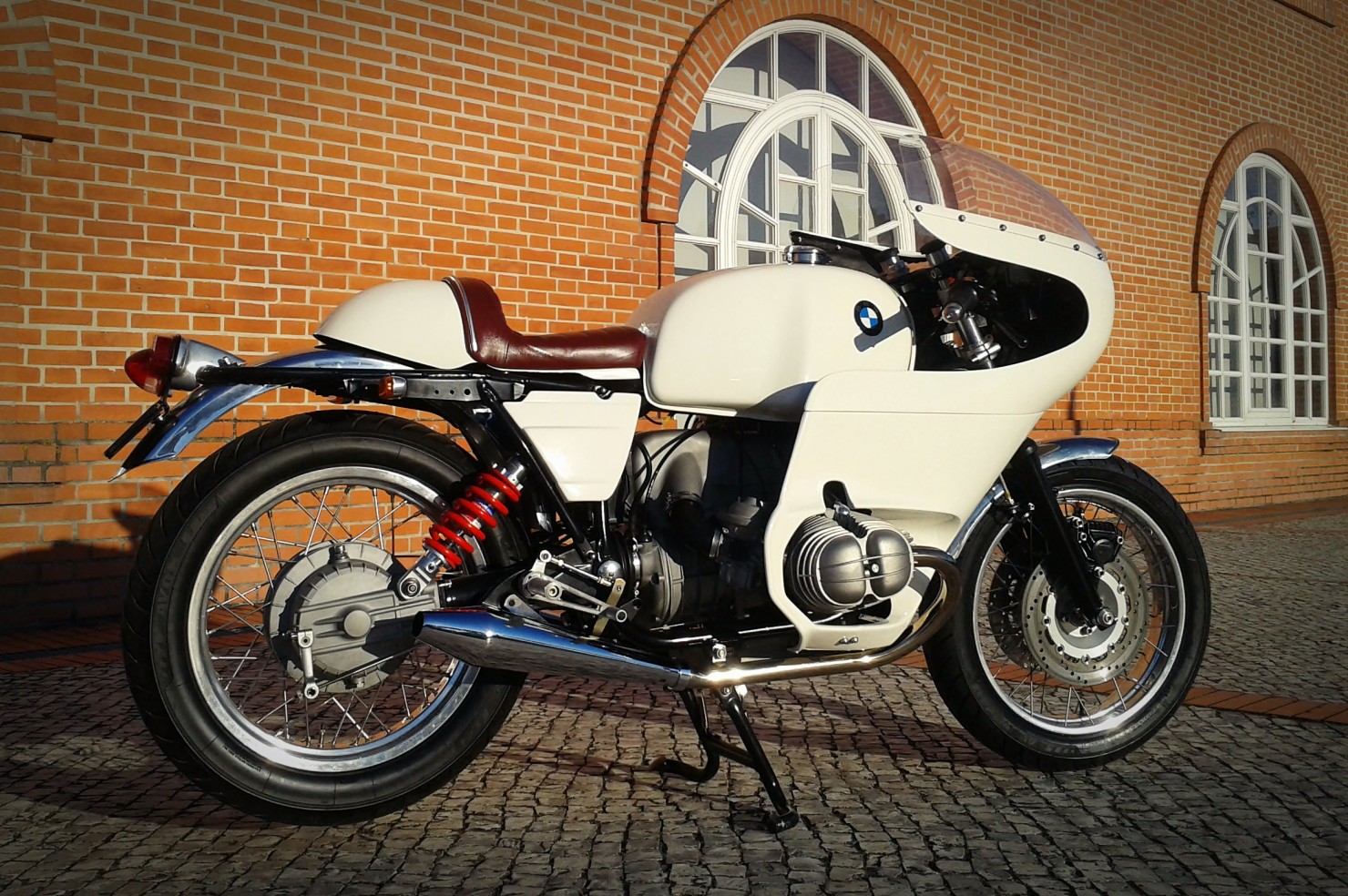
Indian Scout by Analog Motorcycles

With all eyes on Indian Motorcycle’s relaunch of the iconic Scout, it’s refreshing to see vintage examples vying for attention too. And this eye-catching 1949 Scout from Analog Motorcycles should have no trouble stealing a little limelight.
Analog’s Tony Prust stumbled upon the bike while chasing up another lead. “A friend and I headed north to take a look at a Kawasaki W1,” he explains. “While we’re there, we see a rolling chassis and a pile of parts sitting on a bench in the corner. It was a 1949 Indian Scout with a title that the owner had had for seventeen years.”

“He’d several projects going in his shop, and his friends gave him a hard time about the Indian, saying that he was never going to finish it.” After some negotiation, the owner finally relented. “It was pretty far beyond restoration quality,” says Tony, “but had most of the ingredients needed to build a motorcycle.”
The 1949 Scout was built around a 440cc vertical twin in a plunger-style frame. According to Tony, many experts consider it to be the bike that put Indian out of business. “They bought the design from a European company and put it into production without much testing.” (Bonhams has a 1949 Super Scout listed on their site, with a great little history lesson.)

Given the plunger rear end, a bobber-style build seemed obvious. But Tony had higher aspirations for the little Scout, and decided to create a ’60s and ’70s-era race replica. The first step was getting the motor into a better chassis, so Tony called up Randy and Karsten at Frame Crafters in Union, Illinois. “After chatting with them for a bit and realizing how obscure the engine was, we decided to modify a Track Master-style frame that they had in-house. This was the go-to chassis for many racers back in the ’60s & ’70s.”
It took some shoehorning, but Frame Masters managed to squeeze in the Scout’s engine and transmission. Analog then installed a set of vintage Betor forks, matched to modern Gazi shocks, and a new wheel set: TZ750 hubs laced to 18” aluminum rims.

With the rolling chassis sorted, the engine was next on the list. Frame Crafters recommended Bill Bailey of ZyZX Vintage Motorcycles: an ex-racer who had piloted old Indian Scouts and Warriors. “Bill had done a lot of racing and testing, and discovered the engine’s weaknesses and ways to improve it.”
During the rebuild the engine was punched out to 500cc with a hand-cut billet cylinder. The electrical system was converted to 12-volt with an electronic ignition, and the oil cooling system was redesigned and hooked up to a new oil tank.

Next up was the Scout’s bodywork. Tony shaped bucks of the tank and tail sections out of Styrofoam, and sent them off Pavletic Metal Shaping to hand-build aluminum versions. Pavletic also handled the aluminum fairing—based on a wire frame template that Tony mocked up.
Turning to the finer details, Analog fabricated a new exhaust system, terminating in Cone Engineering Stubby mufflers. Tony also fitted Tarozzi rear-sets, with levers that fold out of the way of the kickstart. (Tony lists the redesigned kickstart lever as one of the trickiest parts of the entire project). All the plumbing was replaced by brass lines and braided stainless tubing. The speedo is a one-off from Seattle Speedometer, and Free Form Designs handled the speedo bracket, rear sprocket and oil manifold.

Much consideration went into the final finishes: “The plan was to do raw aluminum, but after seeing a lot of motorcycles coming out in recent months with the same look, I opted to give it more color.” Analog “Scotch-Brited” all of the aluminum bodywork before clear-coating it. Regular Analog collaborators were called in: Kiel of Crown Auto Body for paint, Brando for pin striping and gold leaf, and Art Rodriguez of Rods Designs for the seat’s leatherwork.
Despite the race-inspired looks, the Scout is fully street legal thanks to LED head and taillights. “To keep it in race trim I had Mike Ardito form brass covers to go over the headlight and taillight. While he had the bike, he also whipped up the front fender.”

With parts from every corner of the globe, Analog decided to call the bike the Continental Scout. “The bike was designed entirely by Analog Motorcycles,” says Tony, “but it was my vision to go beyond some of my fabrication abilities—so I called on skilled professionals to achieve the final product. It is without a doubt the most beautiful motorcycle I have created so far and I am extremely proud of it.”
And so you should be, Tony. Now please get cracking on that Kawasaki W1.
Photography by Whiplash Racing Media. To see more of Tony Prust’s work, visit the Analog Motorcycles website.
Full Build Sheet
Track Master style frame made by Frame Crafters
All aluminum tank, seat and fairing designed by Analog and formed by Pavletic Metal Shaping
Brass light covers and fender formed by Mike Ardito
Polishing by Mike’s Polishing, Rodsmith, and Analog
Engine built by Bill Bailey of ZyZX Vintage Motorcycles
Engine has hand-cut billet cyclinder, 12 volt conversion and Dyna III electronic ignition.
Carburetor: Amal 928
Exhaust custom made by Analog with parts and stubby mufflers from Cone Engineering
Custom-made oil tank with internal plumbing made by Chassis Services
All plumbing designed and made by Analog
Paint and clear coat by Kiel of Crown Autobody
Gold leaf and pin-striping by Brando
Seat by Rod’s Designs
Magura controls
Speedometer designed and rebuilt by Seattle Speedometer
Tarrozi rear sets
Betor Forks and triples
TZ750 hubs with custom detailing by Analog
Spokes and rims made by Buchanan’s
Speedo mount, rear sprocket and oil manifold machined by Free Form Design
Gas cap by Crime Scene Choppers
Piaa LED headlights
Radiantz puck LED taillight frenched into seat hump
All custom electrical – battery and fuse block under seat hump
Custom made bar switch by Analog
Modified GSXR windscreen
Maund Speed Equipment velocity stack
Avon Roadrider tires
All custom made cables by Ed Zender at Morrie’s Place
Extremely strange and difficult to design custom kick starter lever (version 5) by Analog
Top oiler lines made by HEL brake lines
The post Indian Scout by Analog Motorcycles appeared first on Bike EXIF.
‘75 Moto Guzzi 850T – Olympia Motorcycles
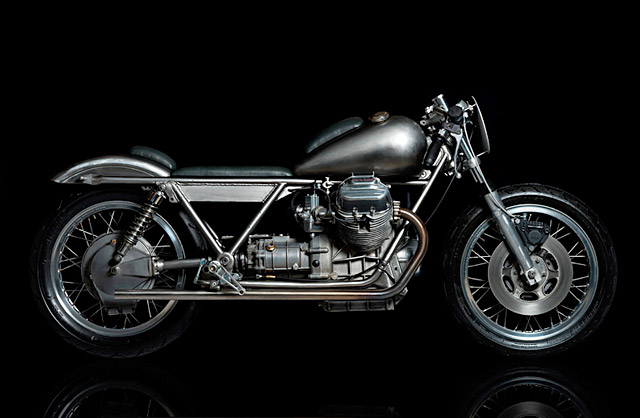
Written by Martin Hodgson.
Building a custom motorcycle that does one thing well is an achievement in of itself, building a custom motorcycle that is capable of being three different bikes is exceptional, from a first time builder it is a Herculean effort. This Guzzi is an automotive piece of sculpture, built for breaking records on the salt flats and registered for the road, it’s three bikes in one and it completes each task with flawless perfection.
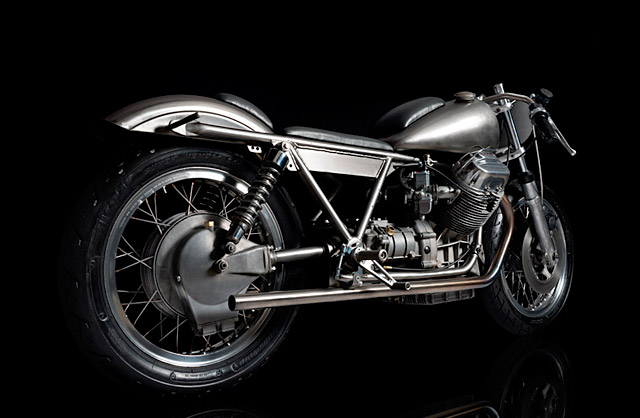
The bike is the creation of Los Angeles artist David Miezal who took his inspiration from German speed merchant Ernst Jakob Henne and the speed trial bikes from days of old. Simple, defined and minimalistic with the purpose of going absolutely flat out across the salt. David started with a 1975 Moto Guzzi 850T, the Italian sports tourer that was arguably the makes best bike of the 70’s. With a strong motor and drivetrain the decision was made to simply give it a freshen up, new seals and gaskets and a carby clean means the bike will run all day long. While modern wiring, new Dyna coils and an updated regulator make the electrics just as reliable.
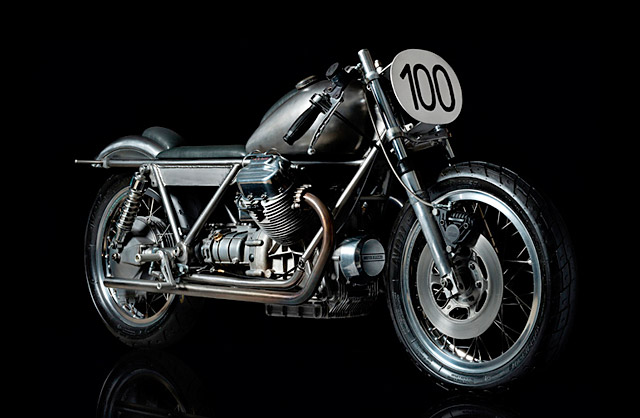
As an artist with a certain vision in mind David stripped the bike bare revealing a blank canvas with which to work. The frame and forks were all de-tabbed, all the unrequired cosmetic clutter was disposed of and anything that doesn’t serve an essential purpose destined for the scrap bin. Both the handlebars and the exhaust were meticulously handcrafted from stainless steel, while the custom under seat electrics box is finished with welds that match the original beads laid down in the factory. Wanting to maintain a certain patina the engine, transmission casing and wheels were all carefully cleaned by hand with David not wanting to remove any of the staining.
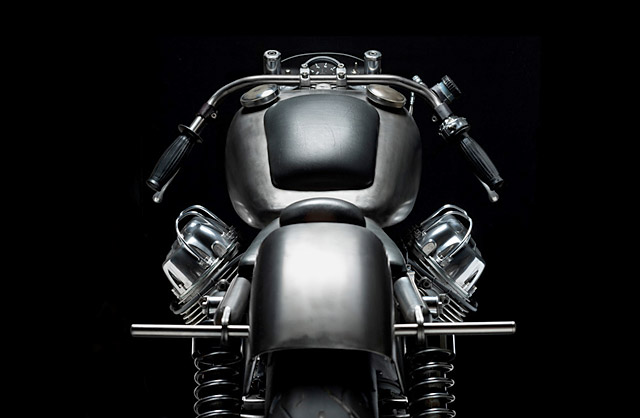
Increasing the visual impact of the bike is the distressed leather used to cover the custom created seat, tank and fender pads. The scars matching well with the hand sculpted and lightly stained body reminding all that this bike really lives. The switch blocks, lights and indicators are long gone, with just GT grips to hang onto, custom rearsets and polished levers to keep control and a single tacho being all that David requires.
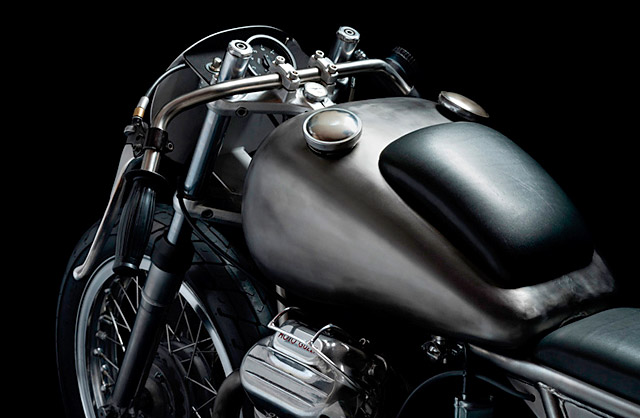
With ambitions of top speed salt flat passes and the ability to ride on the street the suspension and tyres of 40 years ago were never going to do the job. The smoothed out front forks now sport Wirth progressive springs and FAC dampers while the rear is controlled by vintage Bitubo shocks. All of which keeps the new Avon racing rubber firmly pressed into the chosen surface of the day.
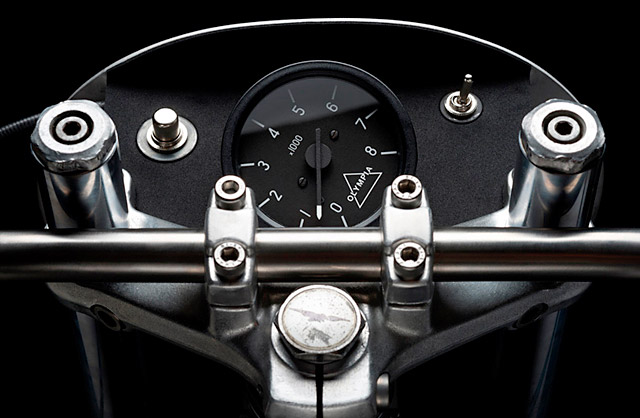
Nicknamed Heracles, both the Italian custom creation and the Greek God exhibit a defined masculinity, strength, courage and ingenuity that will maintain their legend status forever more. And when it’s not doing the ton on the salt or cruising the streets, just like its name sake , this Guzzi would be equally at home in a museum, where even static it can be admired.
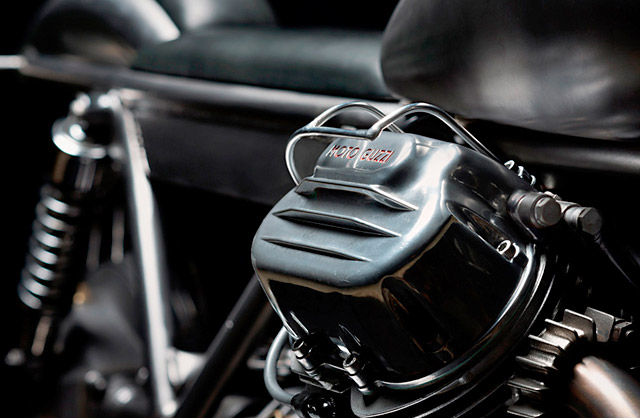
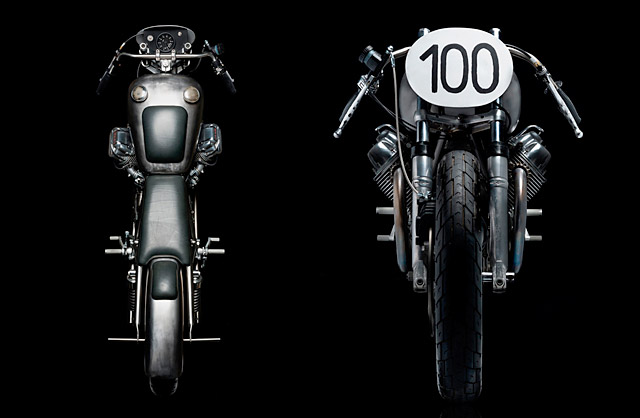 first appeared in http://www.pipeburn.com
first appeared in http://www.pipeburn.com
Saturday, August 23, 2014
Royal Enfield AVL 350 – Bull City Customs
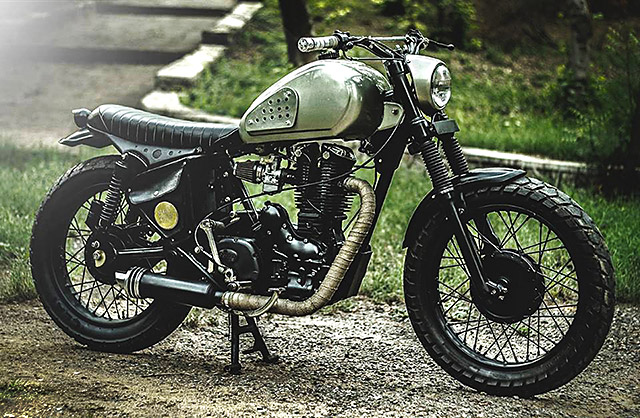
Written by Ian Lee.
Royal Enfield motorcycles make a great platform for building custom bikes. Old school Brit styling, reliable single cylinder engines and factory spoke wheels. This is exactly what New Delhi based Bull City have done with their latest build, putting their skills to work on a Royal Enfield AVL 350cc, and producing something far removed from your everyday Enfield. With a build brief calling for an “old school thumper”, the Bull City workshop decided the idea has been done alot, and needs some special touches in order to stand out. That is why there is a rhino-skin inspired paintjob on the tank for instance – which I’m pretty sure is a first for Pipeburn.
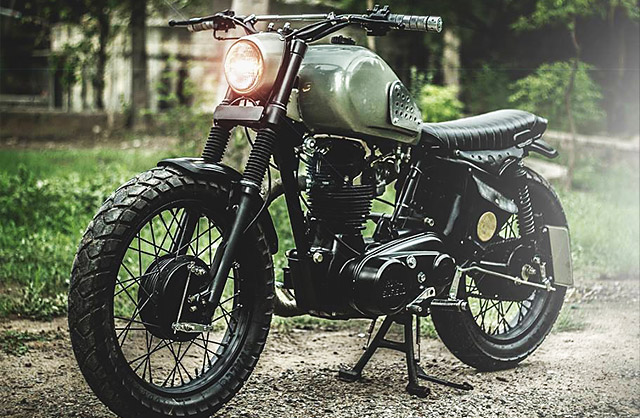
Stripping the mid sized thumper back to basics, the clunky factory fenders were replaced with shorter ones, and the frame shaved of all superfluous bracketry. The toolbox is gone, replaced with a leather carrier bag mounted above the shorty pipewrapped exhaust. New framework has been mounted on the bike, and the battery box is sheet metal unit fabricated up by Bull City themselves.
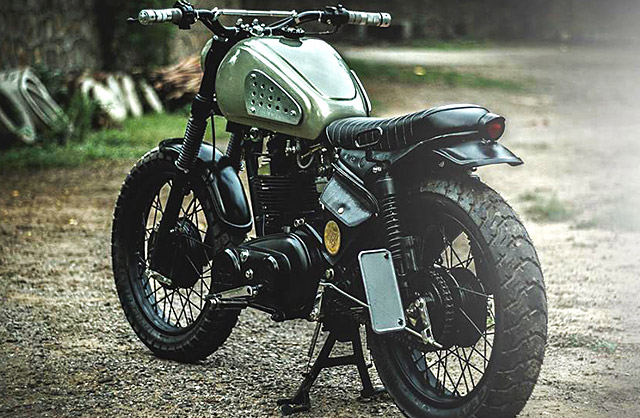
At the front end sits a set of custom built T riser bars, adorned with a unique headlight surround enveloping the Yamaha RX100 headlight. The handlebars are Proracer items, mounted up with aluminised grips. Rolling stock is made up of 18 inch rims, with 120 profile at the front and 130 profile at the rear.
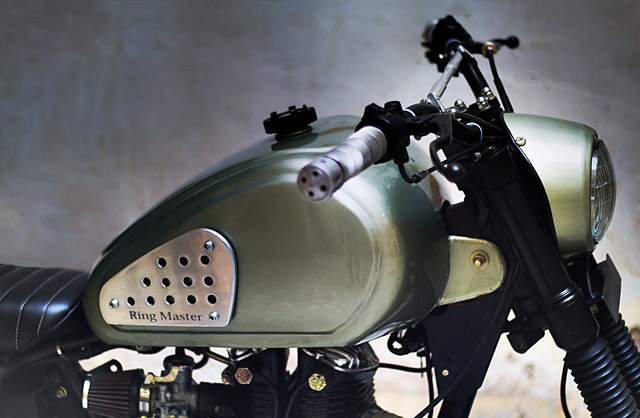
An impressive aspect of the build is the metal work carried out. The 22 litre fuel tank is a one off special, along with the ‘lightweight’ side plates. The foot pegs have been made from Royal Enfield engine internals, adding to the overall metallic touch to the build. This is matched with the fuel tank cap fashioned from a main shaft sprocket.
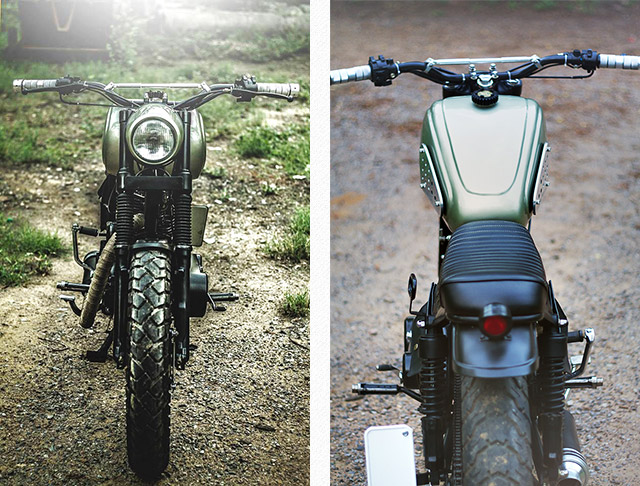
From the front to the back, there is little that hasn’t been aesthetically touched up over the course of the build. With much of the metal work coming from Bull city’s own workshop, this Royal Enfield is definitely a fun looking ride. We’ll leave the last word to Bull city: ” We wanted to build something you’d imagine riding across the Himalayan foot hills and also something you could take out for a beer without a second thought.” We’ll drink to that.
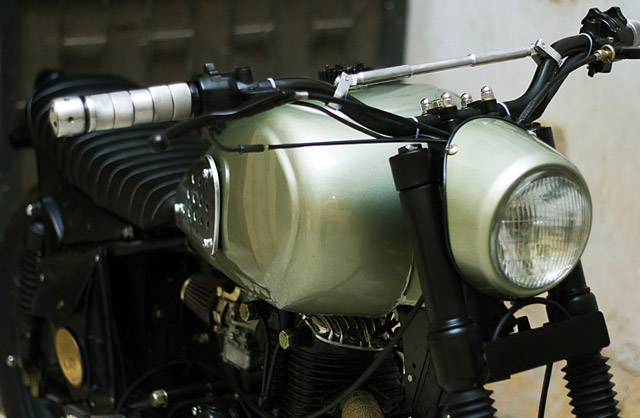
First appeared in http://www.pipeburn.com
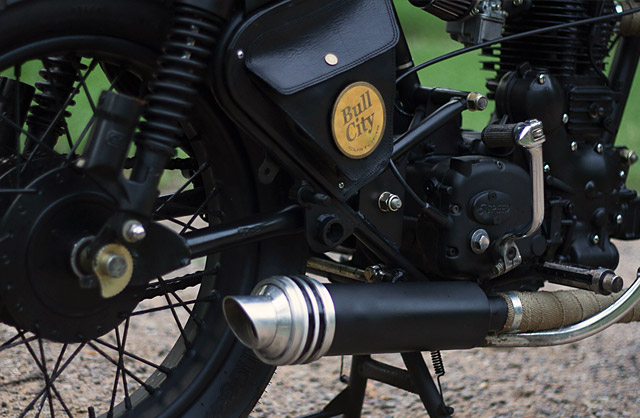
Thursday, August 21, 2014
Drifter Bikes Phoenix

Paul “The Jerk” Stanner of Drifter Bikes is one of those proper Australians. He’s been a pearl diver, crocodile farmer, surfer, drifter and beach bum. His dad is from England and back in the day was a Rocker and a biker, so Paul was destined to catch our unified customisation disease. 15 years ago he moved to the big smoke on the other side of the country and got a grown up job in Sydney. What spare time remained was spent in the backyard shed, building bikes for mates and mates of mates. Currently his 21 month old daughter is not proving to be so productive at welding or lapping in valves, so builds are taking a little longer than Paul is used to.
This Kawasaki W650 is a break from the customer led projects (see the GB500 here) and is a personal ride for Paul, and named after his daughter Phoenix.

The donor is a 2001 model bought on eBay, from a tiny town in Australia’s heartland, far from the sea and rust inducing rain, so arrived in really good condition. A Cafe-Tracker was to be the self imposed brief, so the front wheel was the first job on the bench. The 19″ rim was cast aside and an 18 incher relaced to the standard hub, but a slightly wider 2.15″ to allow for fatter front tyre options. In this case a Pirelli MT90, with the fender chopped and lowered for a close fit.

The arse-end on the Kawasaki W is a tricky thing to get right without hacking our the subframe, in stock form its just too wide at the shock mounts and makes for an overly large seat. Paul saw to this with a hoop that maintained the kick-up but finishes up short, allowing the rear fender to take the mud catching and licence plate holding duties. Neatly tucked away is the stop light, hidden between the curve in the fender and the plate mount. The new gas shocks raise the now fine looking tail by 30mm and provide a simple indicator mounting spot.

A small box under the seat house the boring electrical stuff and the battery has been sent down below to live on the swing arm, leaving breathing space for the more traditional style pancake air filters and rejetted carbs. Paul credits the W650 forum and Guy Sciacca for decent advice on jetting and set up, “Never underestimate the help you can get from complete strangers on some of the great forums”. Stainless headers ensure the breathing out part is both efficient and good looking, leading to a MotoGP-esque silencer which sounds as good as it looks.

The tank concept has been rattling around Paul’s head for a while and Kyle from Smith Concepts managed to drag out the ideas and execute them far beyond expectation. The actual canvas for this artwork was a tank laying around the shed that was massaged into position in an attempt to maintain a parallel line with the bottom and the ground, i’d say that was pretty level.

Manufactures are adept at stuffing inordinate amounts of wiring into headlamps and around cockpits and the W650 offered few hiding places. The mini-fairing looks speak and draws the eye along towards the rest of the tank and provides a small spot to bury cable. Stock handlebar mounts have been shaved and clip-ons mounted straight to the forks. The thin seat has been covered in a rather cool Porsche trim by East Coast Trim Shop.
When you’re working on your own machine there’s definitely a huge amount of satisfaction to be drawn from the process, but Paul is already feeling an itch that needs scratching. Anyone out there want to commission a build and relieve his growing listlessness? Get in touch with Paul here and keep an eye on his Facebook page
Firs appeared on http://thebikeshed.cc
Tuesday, August 19, 2014
The ultimate Triumph Scrambler?

The Scrambler is one of the most-loved Triumph motorcycles of recent times. But there’s a common criticism: its off-road performance doesn’t quite match those beguiling looks.
That shortfall has just been blown to smithereens by a team of five motorcycle engineers. And not just any engineers: they’re all part of Triumph’s own chassis development team, based in Spain and led by brothers David and Felipe Lopez.

Since 2001, these guys have overseen the development testing of every new Triumph model—so you can guarantee that this custom Scrambler can walk the talk.
The bike is called Tramontana, after a northerly wind that blows over the Pyrenees on the border of France and Spain. “That’s what this Scrambler does—it traverses the mountains as fast and as light as the wind,” says David Lopez.
“During the development of the original Scrambler—launched in 2006—the aim was on-road performance, with the capability for very light off-road riding,” says Lopez. “But even then, it the potential for real off-roading was clear. The 270-degree crank version of the parallel twin allowed excellent traction with a good spread of torque. And the ergos and intuitive character of the chassis made it fun to ride on forest tracks.”

A couple of years later, Lopez and his crew handled the development of the Tiger 800XC. And they got thinking about the good off-road potential of big capacity bikes when purposely developed for it. “Our off-road backgrounds were more related to light bikes—trials and enduro,” says Lopez. “So we were surprised by the pleasure of riding bigger bikes in challenging conditions and terrains.”
Lopez and his team have a soft spot for the Triumph ‘Modern Classics’ range, and had been planning to turn one into a high performance cafe racer. But while developing the 800XC, they decided to change tack—and create the ultimate off-road Scrambler.
It took an extraordinary four years of after-hours work. But this machine has gone through the same chassis development process as an ‘official’ Triumph model, with extensive engineering input and equally extensive test-riding.

“We investigated countless different geometries, suspension types, wheel sizes, ergonomics and engine configurations,” says Lopez, “just like we’d have done for a production bike. The development decisions were made with only one target: off-road performance.”
Visually, the starting point was a very ‘classical’ Scrambler look, but the finished machine has more of what Lopez calls a ‘modern-retro’ style.
“It’s got the character of the Scrambler and the sixties Triumphs—provided by the parallel twin and the cradle/twin shock frame—mixed with modern high performance.”

The spec sheet is mouthwatering: multi-adjustable Ohlins suspension, alloy rims, twin front discs, alloy yokes and bars, and a tailor-made Arrow exhaust. Even better is what the bike is missing, to the tune of almost 40kg when weighed next to a stock Scrambler.
As you can imagine, the mods are extensive. So here’s a detailed rundown.
 Chassis geometry “The geometry was developed to provide
a confidence-inspiring ride, balancing front and rear grip—to allow for
easy and predictable rear-wheel drifting.” This geometry was achieved
by repositioning the rear suspension unit top mounts, lengthening the
swing arm, and by changing the forks and yokes.
Chassis geometry “The geometry was developed to provide
a confidence-inspiring ride, balancing front and rear grip—to allow for
easy and predictable rear-wheel drifting.” This geometry was achieved
by repositioning the rear suspension unit top mounts, lengthening the
swing arm, and by changing the forks and yokes.Wheel Base: 1510mm (up 10mm)
Caster Angle: 26.1 degrees (down from 27.8)
Trail: 111mm (up from 105mm)
Dry weight: 178kg (down from a real-world 217kg)
Weight Distribution: 48.5% Front – 51.5% Rear
Suspension “The suspension is now Öhlins, and was specifically developed for this bike. We increased the fork stroke from 120mm to 220mm, and the rear wheel stroke from 106mm to 180mm.” The increased rear stroke comes via clamps machined from solid alloy that reposition the top of the rear suspension unit, which also improves progressiveness.
Wheels Lightweight aluminum spoke wheels from Excel, sized 21” x 2.5” at the front and 17″ x 4.25″ at the rear. “The 21” front wheel is essential to achieve the desired level of grip and control of the front end in off-road conditions.”
Frame Modified to reduce weight by eliminating all non-essential features. The steel fork yokes have been replaced by custom aluminum parts.
Ergonomics The steel handlebars and risers have been swapped out for aluminum bars fitted with Tomaselli grips. The footrests are modified genuine Triumph accessory items, in the 1970s ‘bear trap’ motocross style. “Their position has been changed to lower the rider in relation to the center of gravity of the bike, to improve standing up bike control.” The seat is a one-off, covered with Italian brown leather.
Front Brakes Twin 308mm discs (replacing a single 310mm disc) with two-piston floating calipers by Nissin.
 Bodywork Custom-made side panel and rear mudguard. Black anodized aluminum sump guard.
Bodywork Custom-made side panel and rear mudguard. Black anodized aluminum sump guard.Powertrain Airbox replaced by inlet ports, with individual air filters to improve low and mid-range torque. Re-jetted Keihin carbs. Eliminated secondary air system. Custom-made wiring harness and battery tray. Lithium-Ion battery. Size 17-50 sprockets. Custom-made dynamic chain tensioner.
Exhaust System Custom Arrow brushed stainless steel two-into-one high-level exhaust system, covered with wrapping tape to optimize the exhaust phase.
CNC Machined Components Brake fluid reservoirs, rear brake master cylinder protector, sprocket cover, headlight brackets and protector, twin rear light.
The stock Triumph Scrambler sells for $9,099 in the USA. Perhaps Triumph should take a leaf out of the Street Triple’s book and sell this machine as an ‘R’ version for $11,000—still a grand less than the 800XC. Or put together a kit, so that Scrambler fans can convert their own machines to Tramontana spec.
Would you be tempted?
Images courtesy of Marc Bordons.
The post The ultimate Triumph Scrambler? appeared first on Bike EXIF.
Wednesday, August 6, 2014
76 Kawasaki KZ400 – Tattoo Custom Motorcycles
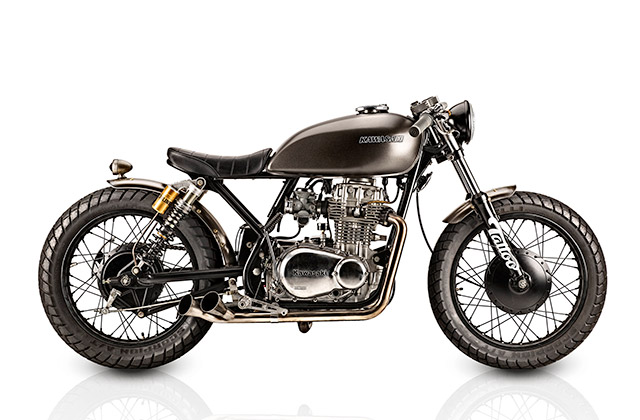
Some of us dream of throwing in the towel on our day jobs to do what we truly love. Whether it’s building custom bikes, opening a café or just taking more time to focus on your family, it’s a fantasy that’s as common as slap bass in Seinfeld. But as with most things inline, there’s another option to consider. What if, instead of leaving one job for another, you just combined your passions and did both? Sounds impossible, right? Well don’t tell that to North Carolina’s Tattoo Projects, who are currently a successful advertising agency and a custom bike shop. It might seem crazy, but when you consider that they count Victory Motorcycles amongst their clients, you can kind of see the logic of it all. And what have they been up to when they weren’t standing around with whiskey and cigarettes Don Draper-ing? This is what.
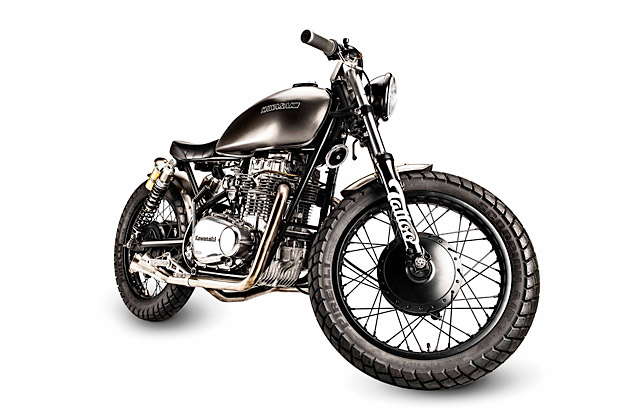
We’ll let Rudy Banny – Tattoo’s Founder and Creative Director – kick things off. “Born from the Tattoo Projects Ad Agency, Tattoo Motorcycles applies the same principles of creativity to customs as we do to making ads for our clients.” On any given day at Tattoo, bikes are being made right alongside tv spots, print ads, and package designs. The Tattoo team suggests that this kind of creative influence produces bikes with an unusual and memorable style… and hopefully some decent bike ads, too.
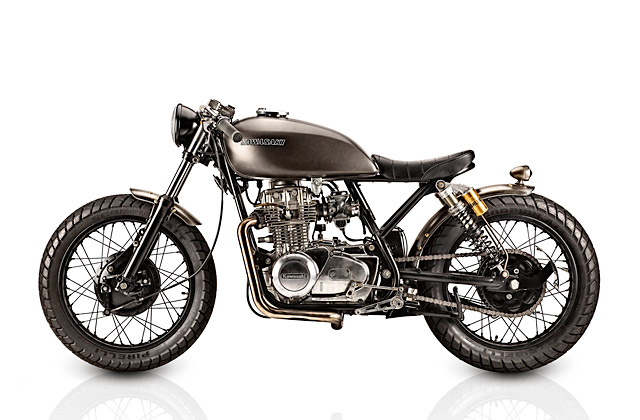
“There’s a few things that characterise a Tattoo bike. A lower stance. A stretched swing arm. A better-proportioned profile. Fatter, gnarlier tires. Powder coating. An exhaust sound you can feel. Great seats. We do whatever it takes to bring out the soul of the bike,” says Rudy.
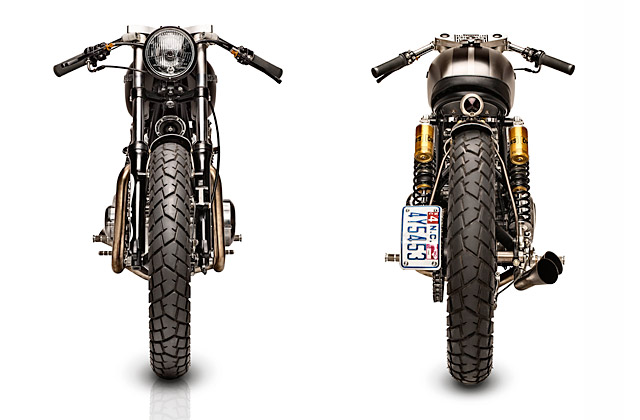
This build was a joint venture with their mates at 2topia Cycles. They agreed to do a steam punk-influenced design on the Kawasaki and things were kicked off with the removal of the bulky rear end and the modifying the sub frame to provide a cool, solid foundation to build on.
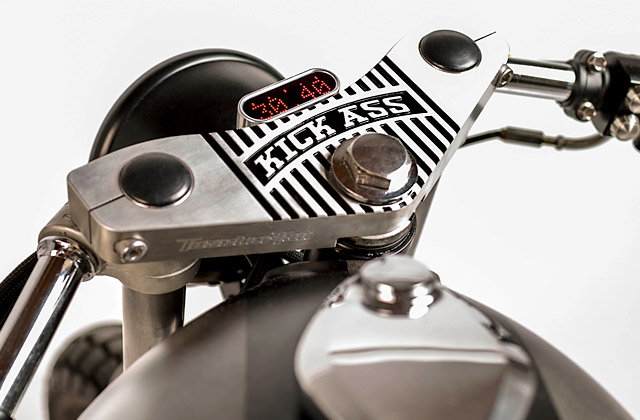
“We went the solo seat route and attached some clip-ons, rear sets and Ohlins shocks. She was really starting to take shape. We had a custom triple-tree machined, we powder coated the wheels and we strapped on some gnarly Pirelli Scorpions.” That’s right about when the boys recruited the help of Nate Hamlin and Bob Iwankow of 2topia to do their magic on that damn, pesky wiring.
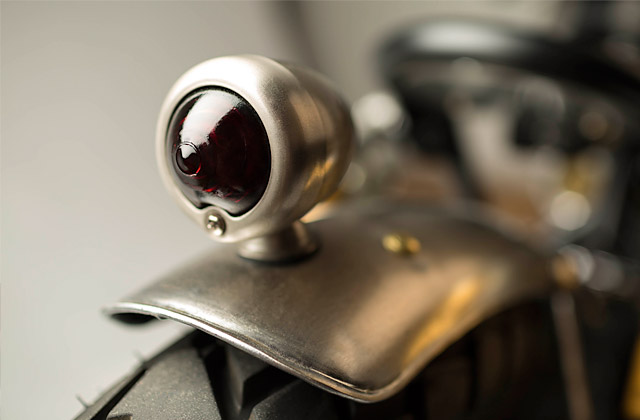
Nate and Bob hooked the KZ up with a complete rewire and buried most of it in the frame while they were at it. Seeing the rather impressive results, it stood to reason that they fit the bike with some slick Motogadget components. And to wrap things up, they broke out their deft fabrication moves to build some bespoke custom fenders and an exhaust set-up. We’re not sure about you, but we’re really liking the twin trumpet look they’ve achieved.
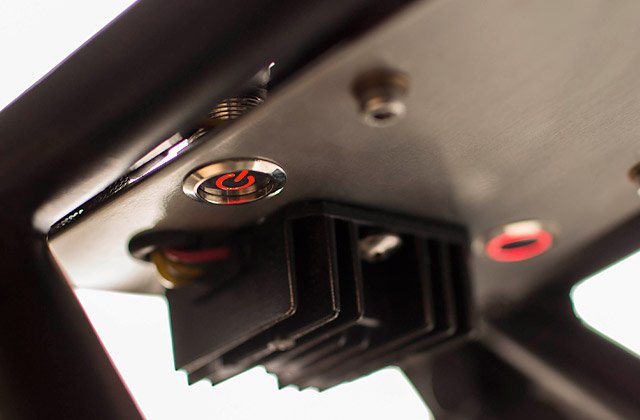
But is it a Mac or a PC?
First appeared in http://www.pipeburn.com/
Subscribe to:
Posts (Atom)




